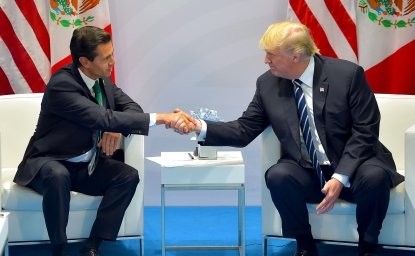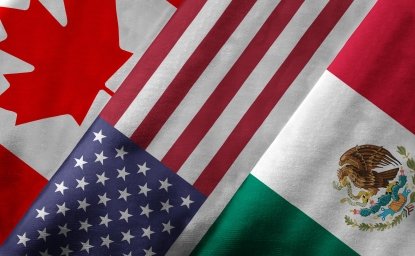The “preliminary agreement in principle” between Mexico and the United States is an important step forward in the effort to agree on a modernized trade agreement in North America.
It is important to recognize, however, that the bilateral U.S.-Mexico agreement is not a good substitute for a trilateral agreement that brings in Canada, America’s largest trading partner.
Much work lies ahead to agree upon a new North American Free Trade Agreement (NAFTA) that will significantly benefit the United States and all of North America. We are on the final lap after a year of negotiations, but a push is needed to get to the finish line.
Having Mexico and the United States agree on most of the key elements of a new NAFTA is significant progress. The U.S. and Mexico have worked through a range of vital issues, especially involving rules for producing autos that aim at increasing North American, and U.S., content.
From Mexico’s perspective, the accord is vital. Mexico sells the U.S. almost 80 percent of its exports. Mexico’s incoming and outgoing presidents both see an agreement as providing stability and predictability that can foster future investment and growth in Mexico.
From a U.S. perspective, Mexico is its third-largest trading partner and second-largest export market, making an agreement critical.
We must not forget, however, that Canada is America’s largest export market and trading partner, so the value of a trade agreement with Canada is beyond question. NAFTA’s importance, however, goes beyond two bilateral relationships.
NAFTA facilitated the creation of a North American production platform in which the three nations combine their comparative advantages by jointly manufacturing goods such as automobiles, with parts and materials moving back and forth across the continental borders.
These productive networks built over the last 25 years strengthen the competitiveness of all three economies. It is far from clear that a U.S.-Mexico agreement alone would be workable or a boon to the United States, given the highly important role that Canada plays in the auto, energy and agricultural sectors. An effective agreement must therefore be regional in nature, incorporating all three North American nations.
Timing challenges pushed the U.S. and Mexico to negotiate intensely so a new accord can be signed this year. Mexico would like the agreement to be signed before current President, Enrique Pena Nieto, who leaves office on Dec. 1.
The U.S. wants an agreement to be considered by the current Congress, which means before the end of the year. Specifically, U.S. trade legislation sets a 90-notification period for Congress, which translates into notifying Congress by Sep. 1 to meet the Dec. 1 goal.
Canada has its own political calendar: There will be federal elections next year. Prime Minister Trudeau cannot be seen to sacrifice the national interest just to get to a deal.
It is vital to recall that NAFTA currently supports some 14 million U.S. jobs, 9 million of which are supported by commerce with Canada.
Congressional reaction to the U.S.-Mexico accord has made clear that many want Canada included and will likely strongly resist a push to approve a bilateral U.S.-Mexico accord that cuts out Canada. Many in the U.S. business and farm sectors share that view.
From an economic perspective, it is far from clear that an agreement without Canada will help American companies compete better internationally, given the costs and disruptions of breaking up North America’s existing supply chains and commercial networks.
With Canadian parts and labor excluded, the bilateral U.S.-Mexico auto deal makes little sense and makes less sense in the context of an integrated regional manufacturing platform.
The U.S.-Mexico agreement, however, takes a big step forward in defining common ground on requirements for content of vehicles considered North American. Canada will now review the agreements from its perspective.
It is also vital that the auto industry and others evaluate the tentative agreement's potential effect on the future competitiveness. Will the new rules and the complicated procedures raise the cost of cars for U.S. consumers and for U.S. exports?
About 20 percent of U.S. vehicle production is exported. More costly U.S. exports will have negative impacts for the industry.
Similarly, private sector input on the other proposed parts of the agreement is essential. Some alarms are already sounding about changes to proposed protections for investors. U.S. unions will also want to examine carefully new provisions to assure labor rights in Mexico.
U.S. energy companies will want to know what changes may have been made in the energy chapter to satisfy Mexico’s incoming administration.
Beyond the vital auto sector, Canada will look over the dispute settlement provisions, which apparently are weakened in the U.S.-Mexico deal. These have been a key concern for Canada from the start of NAFTA.
Some of the draft provisions on intellectual property protection, the internet policies and de minimis tariff limits, among others, go beyond Canadian policy and law.
Also of high priority for Canada and the U.S. private sector is the compromise U.S.-Mexico proposal on a “sunset clause” — a six-year review with an extendable 16-year life span for the treaty. In addition, the U.S. and Canada will need to agree on treatment of Canada’s dairy sector.
Both Canada and Mexico will seek an end to U.S. tariffs on their steel and aluminum.
Prime Minister Trudeau got a lot of Canadian public support for responding firmly to President Trump’s imposition of tariffs on Canada’s metal exports. He will be criticized if he is seen to capitulate, but he will also be criticized if he is seen as contributing to the destruction of NAFTA.
Canadian negotiators will need to show that they are defending national interests. Reaching agreement with all three parties will not be easy, but it is vital.
The bottom line is that there is still much to negotiate and finalize in the weeks ahead. As welcome as a U.S.-Mexico agreement is, the ultimate goal must be a modern trilateral agreement that allows all three North American countries to prosper in a highly competitive global trading system.
This article was originally published on The Hill.









